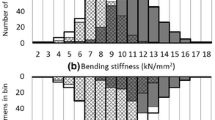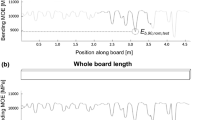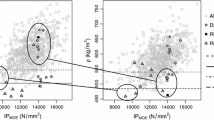Abstract
The quality assurance of timber properties is important for the safety of timber structures. In the current study, the quality control options of timber are analysed for changing material quality under the prism of the different growth regions. Therefore, the control options—machine and output control in accordance with EN 14081—are simulated, and the performance is assessed and compared using 279,235 timber pieces from a production facility. For the data with only grading information available, the real properties were simulated based on 4158 specimens, for which destructive test results are also available. The results indicate that timber with desired material property values can be produced by both machine and output control. In direct comparison to machine control, the output control delivers timber which matches the requirements more frequently as quality shifts can be detected. Whenever lower timber quality is identified, the settings are increased. The output control system for multiple growth regions is not sensitive enough when the current attribute chart given in EN 14081-3 is used. With higher sampling rate the sensitivity can be increased. With the tested option—yield optimization—no additional yield improvement compared to machine control could be achieved.








Similar content being viewed by others
References
Bengtsson C, Serrano E, Fonselius M, Riipola K (2008) Conformity assessment for machine graded timber by using output control. SP Rep 2008:01
Charmpis DC, Panteli PL (2004) A heuristic approach for the generation of multivariate random samples with specified marginal distributions and correlation matrix. Comput Statistics 19(2):283–300
Deublein M, Mauritz R, Köhler J (2010) Real-time quality evaluation of structural timber. In: Proceedings of 11th World Conference on Timber Engineering (WCTE 2010), Riva del Garda, Italy, ISBN: 978-88-901660-3-7
EN 14081-1 (2011) Timber structures—strength graded structural timber with rectangular cross section—part 1: General requirements. CEN European Committee for Standardization, Brussels
EN 14081-2 (2012) Timber structures—strength graded structural timber with rectangular cross section—part 2: Machine grading—additional requirements for initial type testing. CEN European Committee for Standardization, Brussels
EN 14081-3 (2005) Timber structures—strength graded structural timber with rectangular cross section—part 3: Machine grading—additional requirements for factory production control. CEN European Committee for Standardization, Brussels
EN 14081-3 (2012) Timber structures—strength graded structural timber with rectangular cross section—part 3: Machine grading—additional requirements for factory production control. CEN European Committee for Standardization, Brussels
EN 14081-4 (2009) Timber structures—strength graded structural timber with rectangular cross section—part 4: Machine grading—grading machine settings for machine controlled systems. CEN European Committee for Standardization, Brussels
EN 338 (2009) Structural timber—strength classes. CEN European Committee for Standardization, Brussels
Galligan W, Devisser D (2004) Machine grading procedures under the American Lumber Standard. In: Proceedings of 8th World Conference on Timber Engineering (WCTE 2004), Lathi, Finland
Ranta-Maunus A, Denzler JK, Stapel P (2011) Strength of European timber: Part 2. Properties of spruce and pine tested in Gradewood project, vol 179 of VTT Working Papers, VTT, Finland
Sandomeer M, Köhler J, Linsenmann P (2007) The efficient control of grading machine settings. CIB W18 paper 40-5-2, Bled, Slovenia
Sandomeer MK, Köhler J, Faber MH (2008) Probabilistic output control for structural timber: Fundamental model approach. CIB W18 paper 41-5-1, St. Andrews, Canada
Shelley B (1995) Lumber quality control with cusum—issues and considerations. Statistical process control technologies. State of the art for the forest products industry. In: Proceedings from the Statistical Process Control Conference, Forest Products Society, Madison,WI, pp 58–62
Stapel P, van de Kuilen JWG (2010) Growth areas in Europe with regard to different wood species and grading principles. Proceedings of 11th World Conference on Timber Engineering (WCTE 2010), Riva del Garda, Italy, ISBN: 978-88-901660-3-7
Turk G, Ranta-Maunus A (2010) Approach of dynamic production settings for machine strength grading. In: Proceedings of 11th World Conference on Timber Engineering (WCTE 2010), Riva del Garda, Italy, ISBN: 978-88-901660-3-7
Warren W (1978) Recent developments in statistical quality-control procedures for msr. In: Proceedings of 4th Nondestructive Testing of Wood Symposium, Vancouver, Canada
Ziethén R, Bengtsson C, Lycken A (2010) Machine strength grading—“output control” as a method for production control. In: Proceedings of 11th World Conference on Timber Engineering (WCTE 2010), Riva del Garda, Italy, ISBN: 978-88-901660-3-7
Acknowledgments
The support of DOKA GmbH (Amstetten, Austria) in providing the strength grading data is highly appreciated.
Author information
Authors and Affiliations
Corresponding author
Rights and permissions
About this article
Cite this article
Kovryga, A., Stapel, P. & van de Kuilen, J.W.G. Quality control for machine strength graded timber. Eur. J. Wood Prod. 75, 233–247 (2017). https://doi.org/10.1007/s00107-016-1105-3
Received:
Published:
Issue Date:
DOI: https://doi.org/10.1007/s00107-016-1105-3




